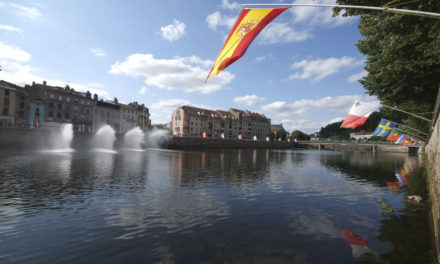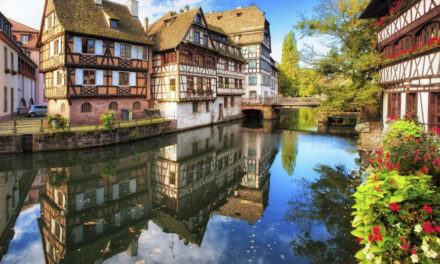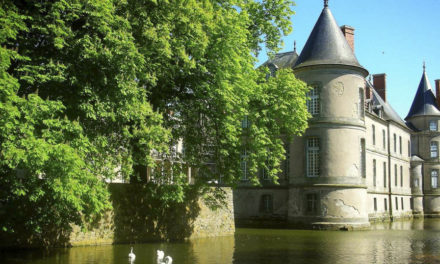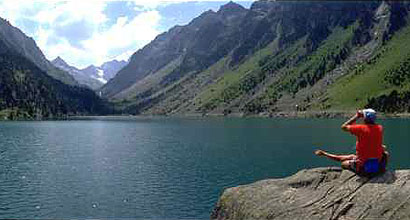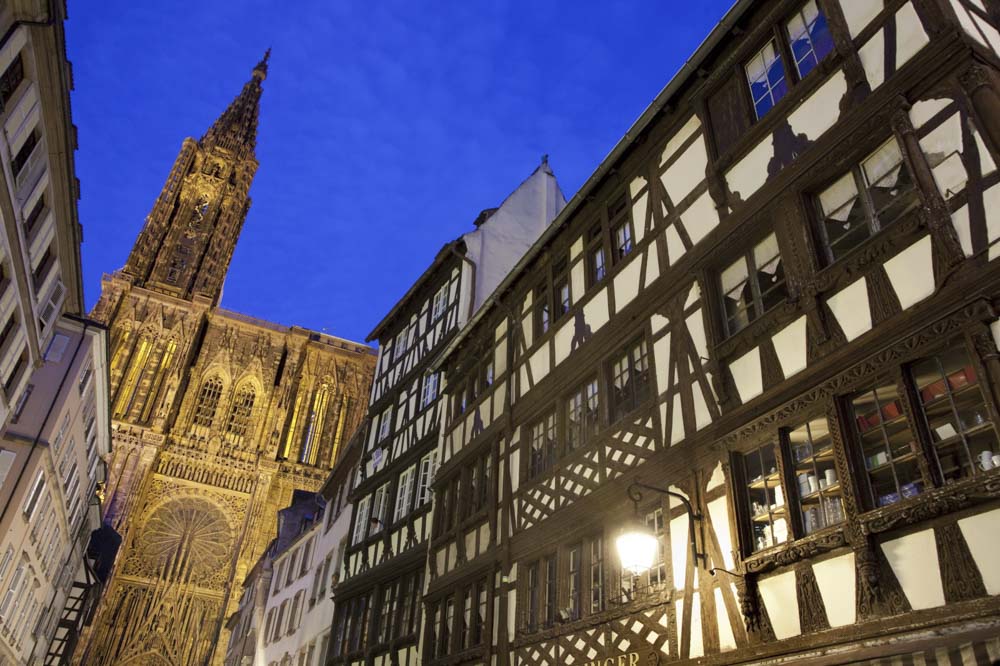
Image – Cathedral of Notre-Dame and half-timbered houses in the old town of Strasbourg, a designated UNESCO World Heritage site, Copyright Atout France/Matthieu Colin
The Grand Est Region now encorporates the previous Regions of Alsace, Champagne Ardennes and Lorraine.
This varied border country which abuts Switzerland and Germany has developed rich traditions and culture from the variety of influences brought to bear on it over the years. From their commanding position high up in the Vosges mountains, the castles of the Grand Est still survey the plain.
The region has, due to its tempestuous history, the greatest number of feudal castles in Europe. More than 400 can still be seen, mostly in ruins, but about 100 remain relatively intact and give a good indication of their former glory. The Massif des Vosges, extending over 6 departments, is a paradise for hikers with over 16,500 kms of paths from simple trails to more taxing routes.
The many activities include cycling, walking and trekking, horse riding, rock climbing, cross country and downhill skiing, golf, ice sports, tobogganing and carting, as well as canoeing, rowing, diving, fishing, swimming, windsurfing and rafting.
Each year more than 8 million visitors flock to the Haut Rhin and Bas Rhin, many attracted by the wines for which it is famous. Since its creation in 1953, the Route des Vins d’Alsace has become, thanks to the 67 villages and towns along the 170 kilometre route, one of the most beautiful in the world. There are 38 wine trails, most with guided tours in July and August. The route winds from north to south past some outstandingly pretty villages.
The vineyards cover thousands of acres lining the slopes of the Vosges with its medieval villages and castles. The winstubs and tasting cellars are a delight to visit. Colmar, Ammerschwihr, Guebwilleer, Turckheim and Ribeauvillé are amongst the main sites for the wine fairs and festivals. The best known wines are Riesling, Gewurtztraminer, Pinot Blanc, Pinot Noir, Le Tokay Pinot Gris, Le Sylvaner, Muscat and the sparkling Cremant d’Alsace.
As you would expect, a rich choice of gastronomic delights accompany these wines and excellent restaurants and auberges abound. Amongst the best known local dishes are Kuglehopf, a rich cake, and Choucroute, once of such national importance that the day the cabbage was salted was declared a public holiday. The landscape is dotted with half timbered villages decorated with brightly coloured flowers and often with two bell towers, one for the Christians and one for the Catholics. Amongst the various wildlife parks is the Garden of Butterflies at Hunawihr, featuring over 200 exotic butterflies from three continents.
Finally, Strasbourg was the birthplace of the “Marseillaise” composed there during the French Revolution in 1792 and known as the “Marseillaise” because of its popularity with the volunteer army units from Marseilles. Not officially adopted until 14th July 1795, it was subsequently banned twice for its revolutionary connections and was not finally reinstated until 1879
The Ardennes, Aube, Marne and Haut Marne whose names are likely to set the taste buds tingling. The home of Champagne, the wine of kings and the king of wines. It must not be forgotten that this superb wine, best known of all French wines has been consumed by the famous from time immemorial. 24 Kings of France were crowned at Reims cathedral and only champagne was served at the ‘sacre’ of Louis XIII. His father Henry IV liked to add to his titles, ‘Sire d’Ay’, Ay being one of the villages where Champagne is made and where he had a ‘pressoir’! With 31,000 hectares under production, the lion’s share of which are in the Marne, followed by the Aisne and Aube, the contribution of the Haute-Marne and Seine-et-Marne’s is almost only symbolic. The area is also famed for its Ardenne patés based on game and wild boar, boudin blanc, pig’s trotters from St Ménehould and the smoked ham from the Ardennes.
Dom Pérignon, born Pierre Pérignon in 1640, was by the age of 28 cellarmaster at the Benedictine Abbey of Hautvillers. With an incredible nose for wines and a rare instinct for blending wines, he is often attributed with being responsible for the creation of the champagne method although records indicate that sparkling wines had been created at an earlier stage. It is, however, likely that he taught blending in the champagne region and introduced the reinforced bottles sealed with Spanish corks to contain this bubbling elixir. The first record of the production of sparkling fermented wine was a century earlier at Limoux in 1531 at the Benedictine Abbey of Saint Hilaire so maybe Dom Pérignon’s expertise had some guidance from there.
The region benefits from fertile plains, forests full of game and yet this now peaceful land has been the subject of many invasions over the years, most of them halting on the banks of the Meuse, Marne or Aube. There are many battlegrounds from the World Wars as well as the last fortress on the Maginot Line. Here there is much for hikers, ramblers and bird watchers to see, especially in the Bocage Champenois where over 40,000 cranes can be seen during migratory seasons. In addition, there is horse riding, cycling, sailing and watersports at the many lakes, canal cruises and hot air ballooning.
There are 108 villages and towns with the ‘flower’ award and many beautiful Châteaux and historic buildings including those of medieval Troyes, the Château de la Motte-Tilly, the half-timbered houses and canals of Châlons-en-Champagne and many others.
The departments of the Meurthe et Moselle, Moselle, Meuse and Vosges are lands of artistic traditions, rich in sandstone, sand, water and wood. Crystal is one of the oldest crafts. Baccarat has been famous for its handblown glass for the past 200 years, but Saint Louis crystal has been produced for over 400 years and is the oldest crystal glass works in France, producing wonderfully coloured pieces engraved and decorated with fine gold. From the 16th century embroidery has been created at Mirecourt and at Lunéville, pearl embroidery is still practised for the couture houses. Here, and at Saint-Clément, china and earthenware have been produced since the 18th century whilst at Longwy, relief or crystal enamel is produced. Mirecourt is the main producer of stringed instruments in France, exporting violins and violoncellos and restoring Stradivarius violins, a tradition which first began in the 17th century as well as the production of organs. The department has more than 1000 organs, 600 of them in the Moselle, making it the second largest collection in France. Steel and iron making was another primary occupation – the Pompey steelworks supplied the 7,300 tons of metal used to make the Eiffel Tower.
The Vosges has a great heritage of art. The Arsenal in Metz is one of the most sought after concert venues in Europe, opened by Rostropovitch in 1989 whilst Nancy has a sumptous Opera house. Nancy was also one of the main centres of ‘Art Nouveau’ in 19th century Europe. The Museum of the Nancy school at the former home of Eugène Corbin has one of the most outstanding collections of art nouveau in the world. Architecturally, the region has many beautiful Cathedrals, Abbeys, Basilicas and Romanesque churches, the most notable of which is St Etienne’s Cathedral in Metz with over 6,500 square metres of stained glass.
The influence of many cultures from Julius Caesar to Louis XIII has bequeathed a variety of architectural works of note from Place Stanislas, Place d’Alliance and La Carrière in Nancy, listed as world Unesco monuments, to Le Corbusier. The village of Hattonchâtel is exceptionally pretty and Bar Le Duc has beautiful renaissance works. Also of architectural and historic interest are the fascinating fortifications of the Maginot Line with their underground corridors and towers and the World Peace Centre at Verdun as well as fortifications by Vauban, medieval remains on the banks of the Moselle and Seille and Roman ruins dating from the 3rd century, all within 30 kms of Metz.
With three nature reserves and over 100 parks and gardens, the Lorraine-Vosges is a botanist’s paradise with over 40 species of orchids, a botanical garden in Metz, over 3500 plants from the mountainous regions of the world at Gondramer, and the 1.5 hectare Parc du Haut-Chitelet, the most comprehensive alpine garden in France. Metz won 1st European Prize for towns with flowers and gardens. Besides the Moselle, Meurthe and Meuse, there are many secondary rivers filled with fish, and lakes fringed with fir trees. Seven ski resorts boast 90 lifts with some floodlit runs.
700 kms of canals cross the region and an ingenious canal lift at Saint-Louis/Arzviller uses 17 locks to climb 45 metres. With five thermal spas, two theme parks, a zoological museum at Nancy, a 600 hectare tourist and thermal complex at Amnéville–les-Thermes, a steam train through the Vallée de la Canner and a miniature railway through the forest at Abreschviller, the attractions are many and varied. Gastronomic specialities include Quiche Lorraine, Verdun sugared almonds, Bulay and Nancy macaroons, Plombières ice cream, chocolate from Metz and Nancy, thistles in liqueur, mirabelle plums in marzipan and finally rum baba, the creation of Stanislas who entertained 300 people every evening at his Château.
There are also excellent beers available and the wines of the Moselle, Meuse and the AOC rosé, Gris de Toul. Copyright: Sarah Francis
Departments in the Grand Est :-
Haut Rhin (68) – Main Town : Colmar
Bas Rhin (67) – Main Town : Strasbourg
Ardennes (08) – Main Town : Charleville-Mézières
Aube (10) – Main Town : Troyes
Marne (51) – Main Town : Châlons-en-Champagne
Haute Marne (52) – Main Town : Chaumont
Meurthe et Moselle (54) – Main Town : Nancy
Meuse (55) – Main Town : Bar-Le-Duc
Moselle (57) – Main Town : Metz
Vosges (88) – Main Town : Épinal



